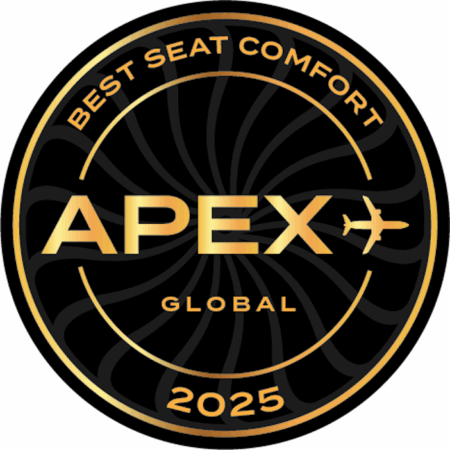Aviation faced its biggest challenge ever in 2020, but with passengers not just returning to the skies as travel restrictions ended, but returning in droves, the industry has been working to meet their needs, and their changing needs and priorities. The latest developments and concepts are reflected in the shortlist for the 2023 Crystal Cabin Awards, the world’s foremost prize for innovation in the aircraft cabin.
After an initial evaluation of the nominations received, more than 80 entries qualified for the eight categories in the 2023 shortlist (Cabin Concepts, Cabin Systems, Health & Safety, IFEC & Digital Services, Material and Components, Passenger Comfort, Sustainable Cabin, and University). The full shortlist is listed below, and the judging process now begins for the jury members ahead of the final awards ceremony in Hamburg on 6th June. So what will they be discussing?
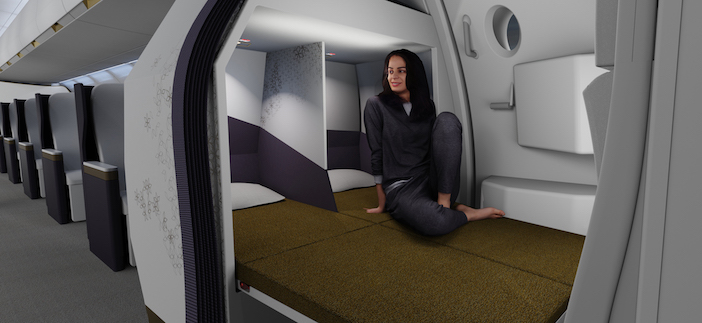
Cabin innovation and design
The part of the awards that always gains the most public attention are the designs and innovations they can experience today or may enjoy tomorrow. For example, the advent of the ultra-long-haul flight is a big talking point, enabled by today’s efficient aircraft such as the Airbus A350 and Boeing 787, with non-stop flights cutting travel time, but adding to the uninterrupted time spent in the airplane. Flying from Auckland to New York could take 17 hours, so passengers will not just want to sleep, they will need to – which isn’t always easy in economy class.
Air New Zealand has a solution with Skynest, the world’s first sleeping pods in the sky. which give economy passengers access to a few hours in a real, flat bed (six bunks are available, for a fee). The airline invested five years of research and development time into creating the Skynest bunk beds, and they are likely to be a hit when they launch in 2024. You can read more details HERE, take a video tour HERE, hear from the development team HERE, and read our interview with Kerry Reeves, Air New Zealand’s head of airline programmes HERE.
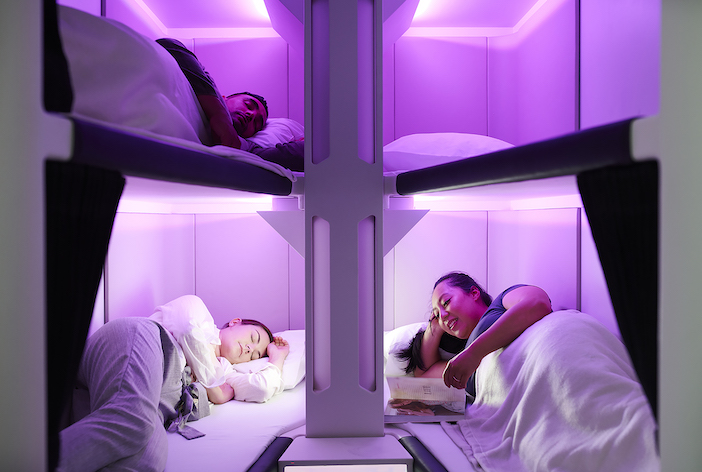
Ultra-long-haul flight is also the theme with the Paradym concept by LIFT Aero Design, which challenges conventional notions of product division (business/premium economy/economy class), with the various classes usually in separate cabins. Paradym is egalitarian in feel, and a simple, flexible idea for airlines to install, and to sell using their existing revenue management tools. The spacious triple seats can be quickly adapted to different levels of comfort, allowing an airline to sell any location in the cabin as extra comfort economy, premium economy, or ‘economy flat’ with a sleeping surface that is 6ft/185cm long, helping ensure the cabin is optimised to passenger satisfaction and revenue on every flight.
Daniel Baron, managing director of LIFT Aero Design, shares more details HERE.
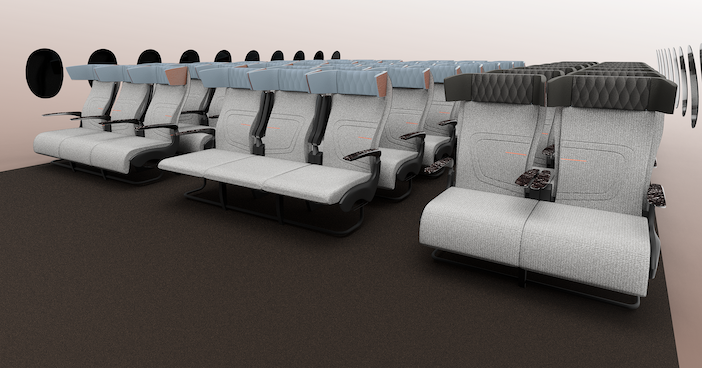
American Airlines has also been developing its next generation long-haul flight experience. The team has worked with Teague on a new cabin concept with various layouts for widebody and narrowbody aircraft that provide a neat solution for a well-known problem: the front seat row in premium economy faces a partition instead of a backrest, forcing designers to build tables and IFE screens into these passengers’ seats rather than the surface in front, which in turn pushes up maintenance requirements. Instead, American Airlines’ concept incorporates tables and screens into the front wall to serve the first row of premium economy, reducing maintenance and creating a more equal experience between seats. You can see the design, and the other new products in the airline’s Airbus A321XLR and Boeing 787-9 interiors launching in 2024 HERE.

The Lufthansa Group is in the running with a huge project: Allegris. This aircraft interiors upgrade programme includes upgrades throughout its long-haul aircraft fleet, from first class to economy. The programme will see around 27,000 seats installed across the group’s new widebody aircraft, including Boeing 787-9s, Airbus A350s and Boeing 777-9s, and retrofitted on the Boeing 747-8s already in service. The new cabins will be rolled out from autumn 2023, and you can find out more HERE.
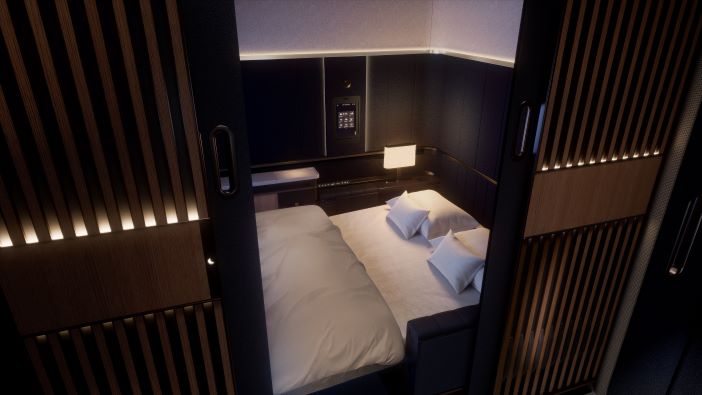
Making the cabin more sustainable
Sustainability is a hot topic in every industry, but aviation has perhaps the toughest job to improve its green image. Aircraft, as well as their engines and fuels, are becoming more efficient, and the cabin and inflight service can also play a part, whether through weight reductions, waste reductions or a more environmentally friendly lifecycle.
The judging panel will be considering the benefits of the BioMat sidewall panel from Airbus Operations, which is comprised of recycled carbon fibres from its A350 production line, mixed with synthetic resins garnered from by-products of sugar cane processing.
Meanwhile, the cabin outfitters at Austrian company F/List have two new bio-based materials in the running for a Crystal Cabin Award trophy: Linfinium, a linoleum covering made from natural components, and the plant-based Whisper Leather.
Another green idea is the Food Waste App from Lufthansa Industry Solutions, which uses AI to measure what passengers leave on their trays, and how much of it, and makes suggestions for tweaks to the catering plan based on this information, to reduce food wastage.
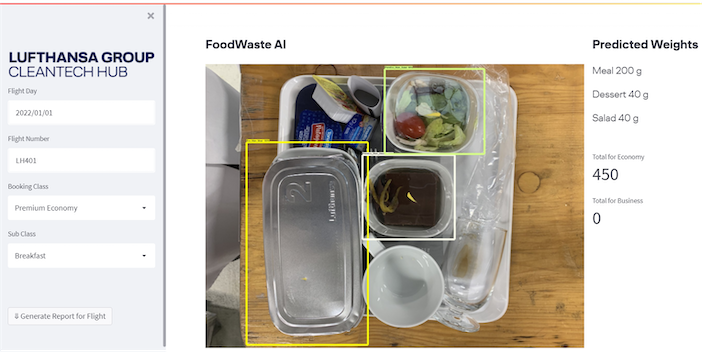
Breaking down barriers: More accessibility for all
Air travel should be safe and enjoyable for all. Sadly that isn’t always the case for all passengers, particularly those with reduced mobility (PRMs), which reflects badly on aviation, and is bad for business, given that around 15% of the world’s population lives with some kind of disability. Most years, new ideas for PRM travel are in the running for a Crystal Cabin Award, and for 2023 several entrants made the shortlist with concepts for barrier-free travel.
Fresh ideas always come from the University category of the awards, which gives students a unique opportunity to present their ideas to an international audience of experts and to key figures in the aviation industry. Students from two American universities, the University of Michigan and the Virginia Tech, have entered the contest with concepts to make air travel safer for wheelchair users.
Looking further ahead, a concept from Supernal (in cooperation with Formation Design Group) considers Urban Air Mobility, with a concept for barrier-free use of air taxis, from gate to exit.
Formation Design Group also proposes Dovetail, an autonomous boarding platform that rolls passengers directly to the aircraft and could significantly reduce boarding and de-boarding times.
Not just planes: cabin innovations for air taxis
Continuing the theme of Urban Air Mobility, in 2023 the Crystal Cabin Award team received more entries for electric Vertical Take-Off and Landing aircraft (eVTOLs) than ever before. EVE Mobility and Almadesign have entered this year’s race with a sleek four-seater cabin concept for Eve Air Mobility, a daughter brand of aircraft manufacturer Embraer. Elements such as ceiling projection and pleasant colour moods are crafted to make the short flight experience as comfortable as possible.
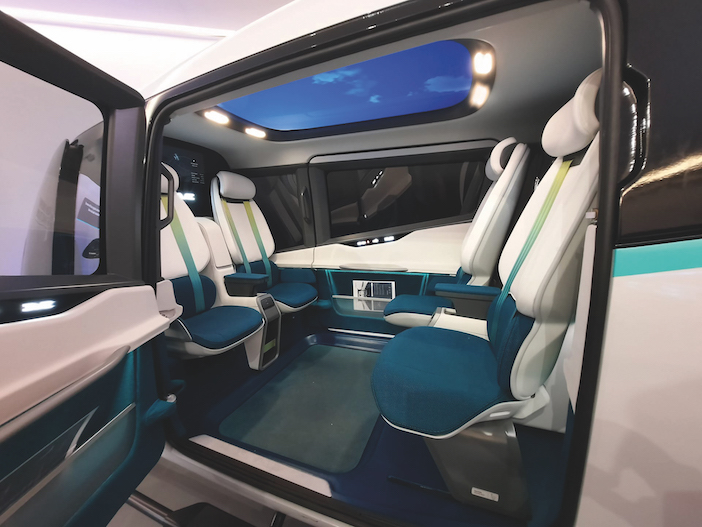
HT-01, a cabin concept for air taxis by Hyundai Transys and its cooperation partner, PriestmanGoode, also uses attractive colours and makes optimal use of limited space. Building on the idea that the urban air shuttles of the future will be shared with other passengers, the South Korean company has included a variety of ideas to ensure a degree of privacy for all four seats.
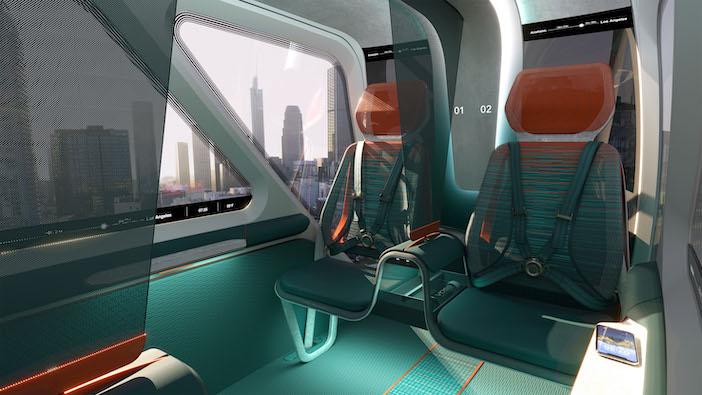
Meanwhile Lilium has approached its cabin concept with a strong focus on exclusivity. The Pioneer Edition Lilium Jet features a very light and airy interior design with many customisable options, including a sky bar.
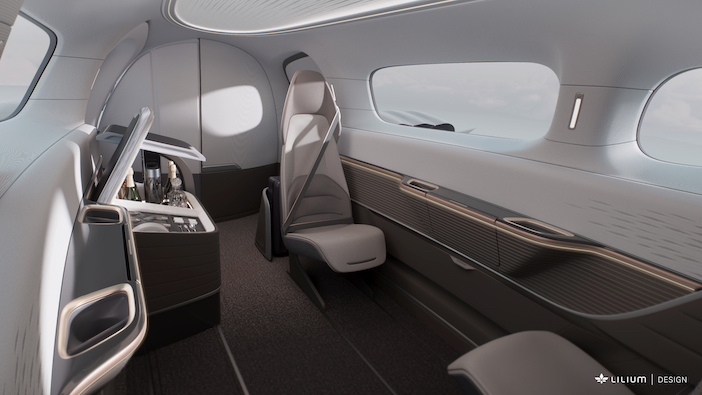
Broadening horizons: creative Ideas with the power to surprise
A few ideas are smaller in scale, such as Air Premia and Zoslee Studio’s idea for a more efficient stacking method for economy tableware that gives it a new, oval shape.
And as more passengers use inflight connectivity to conduct work meetings and other conversations via the likes of Zoom, they can be afforded some privacy with Skyted’s noise-cancelling mask. The design might have looked a little odd a few years ago, but Skyted says the Covid-19 pandemic made mask-wearing so widely accepted on aircraft that fellow passengers won’t bat an eyelid. The face covering was developed together with PriestmanGoode, Airbus Development, the European Space Agency Accelerator Program and ONERA.
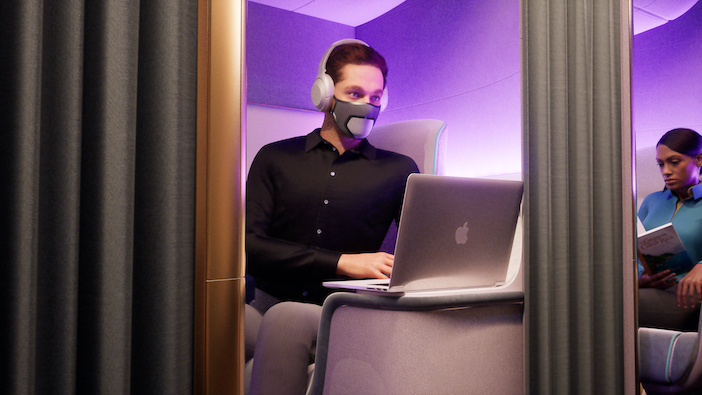
Going back to more typical cabin innovations, the partitions in the aircraft cabin can become see-through thanks to the transparent ‘The Smart View’ displays developed by Hamburg-based AerQ in cooperation with Boeing EnCore Interiors.
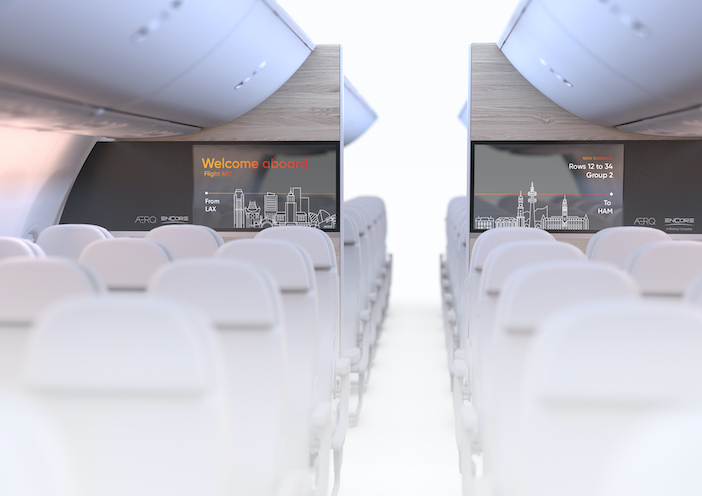
What’s next?
The 28 experts in the Crystal Cabin Award judging panel will vote on the shortlist, creating three finalists for each of the eight categories, which will be announced in May 2023. The panel includes Adam Gavine, editor of Aircraft Interiors International, and some new names for 2023. Participating for the first time are Wahli Ong, VP of product innovation at Singapore Airlines, and Mariya Stoyanova, director of product development at jetBlue.
The finalists will then have the opportunity to present their concepts in person to the jury at the world’s leading trade fair for aircraft cabins, Aircraft Interiors Expo (6-8 June 2023 in Hamburg). The winners of the Crystal Cabin Awards 2023 will be announced on the evening of 6th June at a gala dinner at the Hamburg Chambers of Commerce.
THE CRYSTAL CABIN AWARD 2023 Shortlist
Entrant Name of Entry
• ABOVE ABOVE – Smart media, ready to go
• Acro Aircraft Seating Series 9
• Adient Aerospace, coop. Boeing EnCore Interiors Front-Row Business Class Retreat
• AERQ GmbH, coop. Boeing EnCore Interiors The Smart View – bringing digital & spatial transformation to the cabin
• Air Liquide F90 Protective Breathing Equipment (PBE) Smoke Hood Technology, for Cabin Crew Members
• Air New Zealand Business Premier LUXE
• Air New Zealand Skynest
• Air Premia & Zoslee Studio Stacked Meal
• Airbus Operations GmbH A350 Airspace Cabin
• Airbus Operations GmbH,
coop. Mitsubishi Chemical Group MCG, CTC GmbH BioMat Sidewall Panel
• Airbus Operations GmbH HBCplus
• Aircraft Cabin Modification GmbH ActiveRest
• Aircraft Innovations GmbH AvioSleeper
• AirFi, coop. Iridium LEO Connectivity Solution
• Ameco Seat-Lite Aircraft Seat
• American Airlines, coop. Teague Next Generation Premium Passenger Experience
• Anker Gebr. Schoeller GmbH & Co. KG AIRlight Eco
• Apios Reflect
• Bombardier Challenger 3500
• Carleton University Cirrus
• Collins Aerospace InteliSence
• Collins Aerospace Pothos
• Collins Aerospace Q-Tech
• CTT Systems AB Humidification Onboard Pure Air
• Delta Flight Products SkyPulse software system showing live IFE data tracking
• Deutsche Telekom AG, Lufthansa FlyNet App – mobile extension of
coop. Deutsche Lufthansa AG Lufthansa’s FlyNet on-board internet service
• Diehl Aviation Crew rest compartment for single-aisle aircraft
• Diehl Aviation MLS Mechanical Lift Support
Diehl Aviation Cabin Lining with Integrated Vacuum Insulation
• EVE Air Mobility, coop. Almadesign, Lda EVE
• F/LIST Linfinium
• F/LIST Whisper Leather
• FLOWCO & Almadesign, Lda Eco Friendly Tiles
• Formation Design Group Dovetail
• Hochschule Reutlingen Caféviation Design Concept
• Hughes, an EchoStar Company Hughes LEO In-Flight
• Hyunday Transys, HT-01 Urban Air Mobility Cabin Concept
coop. PriestmanGoode
• IdeaNova Technologies IFE That Flows
• Inflight Canada IFC Passenger Accessibility & Services System (PASS)
• Intelsat US LLC, coop. Stellar Blu ESA Multi-orbit Antenna
• J&C Aero Jump Seat Duo
• Jamco Corporation, Evo Heat Cover
coop. Elmo Leather, C. H. Mueller
• KID-Systeme GmbH, QuickMount off-seat retrofit solution
coop. AviaDeCo GmbH, interiorsDirect GmbH
• Lantal Textiles AG Deep Dyed Carpet
• LIFT Aero Design PARADYM 2.0: Flexible Premium Economy Concept for Ultra Long Haul
• Lilium GmbH Pioneer Edition Lilium Jet
• Lufthansa Group, coop. Caynova Caynova’s Seat Heating & Cooling System (HCS) and Shoulder Sink-In (SSI) for Lufthansa Group (LHG)
• Lufthansa Group The future Lufthansa Group cabin
• Lufthansa Industry Solutions AS GmbH Food Waste AI
• Lufthansa Industry Solutions AS GmbH EPACTO
• Lufthansa Technik AG, Magnetic Latch
coop. Jul. Niederdrenk GmbH & Co. KG
• Metzo GmbH, coop. The Vita Group Reaching new heights with Orbis
• Rollon S.p.A. Privacy Divider Actuator
• Safran Euphony
• Savannah College of Art and Design Tilde Aviation Concept
• Seamless Air Alliance Seamless Certification Program for Inflight Connectivity
• Skyted, coop. PriestmanGoode, Skyted
Airbus Development, the European Space
Agency Accelerator Program and ONERA
• SmartTray International, LLC SmartTray X7T
• Stelia Aerospace Crew Service Application
• Stelia Aerospace, coop. Design Investment Rendez-Vous
• STG Aerospace saf-Tglo SSUL-X11
• STG Aerospace The Curve – LED Flexible Light
• Supernal, coop. Formation Design Group Supernal Uplift Universal Travel Strategy
• T36 Taller de Arquitectos Multicabin Concept
• TCI KABİN Milligram
• Teledyne Controls LLC Teledyne ACES (Aircraft Cabin Environment System)
• Thales Avionics FlytLIVE powered by SES-17
• Thales Avionics Onboard Data Center
• Tongji University GAAS – Galleys As A Service
• TU Delft Alba Seating Concept – human contoured ultra-light aircraft seat
• TU Delft, coop. Embraer S.A. Horus
• TU Delft, coop. Embraer S.A. Interior light perception and enhanced emotions
• TU Delft, coop. Embraer S.A. Lightweight aircraft seating
• Turkish Airlines Inc Green Class Concept
• University of Cincinnati, Activity Pod
coop. The Boeing Company,
The Livewell Collaborative
• University of Michigan, coop. Collins Aerospace, M-SAAVE Wheelchair Accessibility Mission (WAM)
The Boeing Company, All Wheels Up,
Wichita State University NIAR, MGA Research Co
• Virginia Polytechnic Institute and State University, WSSS (Wheelchair Space and Securement System)
coop. Boeing, All Wheels Up
• Unum Aircraft Seating, Seat Component Part Marking including Recycling Reference Code
coop. Green Cabin Alliance





